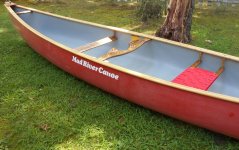G
Guest
Guest
On the other thread you mentioned
I have drawn in several canoes and inch or two. Both RX and composite hulls. The occasional wisdom is that you will hog the canoe or perceptibly alter the rocker.
I am calling nonsense on that. Reducing the sheerline an inch or two isn’t going to do bupkiss to the bottom shape or the rocker, especially on a firmed-up, foam core set in its ways RX hull. A 2 inch sheerline reduction over a 16 foot canoe is (where’s my calculator?) a 1/96[SUP]th[/SUP] change. If the hull has any arch or vee in the bottom shape that will be unnoticeable.
All you will do is add some tumblehome and make the chines sharper; I have yet to see the bottom hog or any appreciable change in rocker with an inch or two reduction in gunwale width.
The sharper chines will make the hull a little more catchy on eddy lines, but again 1/96[SUP]th[/SUP] isn’t much.
I drew in an older flared kevlar composite canoe by 4 inches total, two on each side. That had zero measured impact on the rocker or bottom shape. It did put so much stress on the now very sharp edges that the stretched gel coat on the chines spider cracked in moderately abusive use
On an old, set in its ways Royalex hull I don’t believe you will see anything except a narrower gunwale line and slightly sharper chines, and most of that newly induced tumblehome tuck-in takes place well above the waterline.
For a mostly solo paddled canoe, go for it.
I was also wondering if it possible to pull the hull in a bit...an inch? Two? This canoe will be paddled mainly solo now. I am thinking the more I pull in (if at all), the less stable it will become.
I have drawn in several canoes and inch or two. Both RX and composite hulls. The occasional wisdom is that you will hog the canoe or perceptibly alter the rocker.
I am calling nonsense on that. Reducing the sheerline an inch or two isn’t going to do bupkiss to the bottom shape or the rocker, especially on a firmed-up, foam core set in its ways RX hull. A 2 inch sheerline reduction over a 16 foot canoe is (where’s my calculator?) a 1/96[SUP]th[/SUP] change. If the hull has any arch or vee in the bottom shape that will be unnoticeable.
All you will do is add some tumblehome and make the chines sharper; I have yet to see the bottom hog or any appreciable change in rocker with an inch or two reduction in gunwale width.
The sharper chines will make the hull a little more catchy on eddy lines, but again 1/96[SUP]th[/SUP] isn’t much.
I drew in an older flared kevlar composite canoe by 4 inches total, two on each side. That had zero measured impact on the rocker or bottom shape. It did put so much stress on the now very sharp edges that the stretched gel coat on the chines spider cracked in moderately abusive use
On an old, set in its ways Royalex hull I don’t believe you will see anything except a narrower gunwale line and slightly sharper chines, and most of that newly induced tumblehome tuck-in takes place well above the waterline.
For a mostly solo paddled canoe, go for it.



